|
CONFERENCES
2012 Conference
|
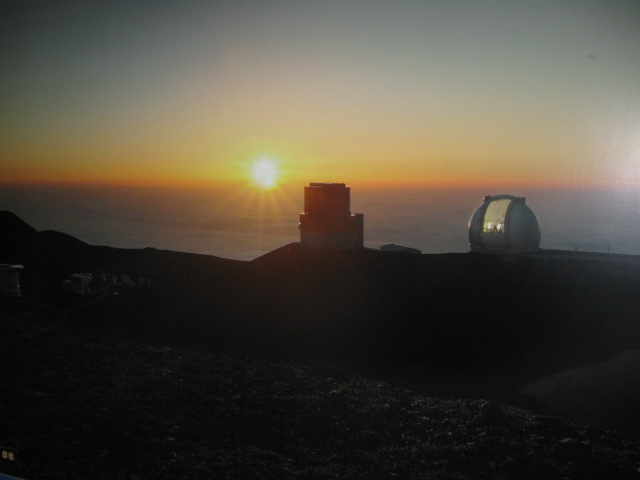 |
METER-CLASS
ASTRONOMY
Telescopes, Instruments, and Observational Programs
2012 Hawaii
Conference
Canada-France-Hawaii Telescope
Headquarters
January 20-22, 2012
Pre-conference Tours January
18-19, 2012
Click here to
visit conference website |
|
Overview
Co-chairs: Russ Genet and Bruce
Holenstein
Tour of Volcanoes National Park 18 January
Insider’s tour of Mauna Kea Observatories 19 January
Mauna Kea observing session (HP) evening of 21 January
This conference was devoted to the development,
instrumentation, and use of meter-class telescopes—with
emphasis on lightweight, low cost telescopes in the
aperture range of 0.5 to 2.0 meters. Advances in
lightweight, low-cost meniscus, foam glass, and
spin-cast epoxy mirrors were covered, as were low cost
active primary and secondary mirror systems. The
structural design of lightweight telescopes was examined
with a detailed look at a recently designed portable 1.5
meter telescope that weighs less than 500 lb.
Instruments and observational programs well suited to
meter-class telescopes include high-speed photometry,
near IR photometry, low resolution spectroscopy, and
polarimetry. There was a special session on visual
observations with meter-class telescopes. The conference
concluded with a panel discussion on the current status
and future prospects for meter-class telescopes,
instruments, and observational programs.
Email contacts: RussMGenet@aol.com, BHolenstein@Gravic.com |
|
Agenda
Pre-Conference Tuesday 17 January, Early
Arrival Get Together
5:00 PM Early arrivals gather for drinks and watch
sunset, no host dinner at Bongo Bens, 75-6819 Alii
Drive, Kailua-Kona HI 06740, 808 329-9203. It is an easy
walking distance from the Royal Kona Resort, 75-5852
Alii Drive, Kailua-Kona HI 96740, 808 329-3111.
Pre-Conference Wednesday 18 January, Tour of
Volcanoes National Park
8:15 Meet in Lobby Royal Kona Resort for tour
participants
8:30 Depart Royal Kona Resort for Volcanoes National
Park
10:00 Main museum/Thurston lava tube/crater rim
12:00 Lunch Kilauea Lodge, 19-3948 Old Volcano Rd,
Volcano Village HI 96785, 2:00 Jager Museum
3:00 Depart Jager for Kona
5:30 Meet at Bubba Gump’s in Kona for no host sunset
dinner, 75-5776 Alii Drive, Kailua-Kona HI 06740,
Pre-Conference Thursday 19 January, Tour of
Telescopes on Mauna Kea
8:15 Meet in Lobby Royal Kona Resort
8:30 Depart Royal Kona Resort for CFHT HQ in Waimea
9:30 Depart from CFHT Headquarters in Waimea for HP on
Mauna Kea
10:30 Arrive HP Visitor’s Center
11:00 Lunch at HP
12:15 Depart HP for summit
1:15 Visit 10 meter Keck gallery (20 minutes, both
groups)
2:00 Group #1 tour Gemini telescope / Group #2 tour CFHT
(tours 45 minutes)
3:00 Group #1 tour CFHT / Group #2 tour Gemini (tours 45
minutes)
4:00 Depart summit for CFHT HQ Waimea
5:00 Depart CFHT HQ Waimea for Kona
6:30 Open Dinners
Conference Day 1, Friday 20 January
7:45 Meet at Royal Kona
8:00 Depart Royal Kona Resort for Waimea
9:00 Coffee at CFHT HQ for early arrivals
9:30 Session I Telescopes I
Welcome, Christian Veillet, Director CFHT
Conference administration, Bruce Holenstein, Gravic
Self introductions around the table
The Alt-Az Telescope Initiative: a personal perspective,
Russ Genet, Cal Poly State Univ.
10:30-10:45 Break
The nature of telescope design, Mel Bartels, BB
Astrosystems
PlaneWave Instruments developments, Dave Rowe, PlaneWave
Instruments
Control systems: new life for old telescopes, Dan Gray,
Sidereal Technology
12:15 Lunch
2:00 Session II Telescopes II
The Cal Poly 18 Direct Drive Robotic Telescope, Richard
Berry, WVI *
Structural analysis of 1.5 meter telescope, Laura Rice,
Cal Poly State Univ.
Telescope structures: 1.5 meter cell, Donny Mott, Idaho
3:15-3:30 Break
Overview of 0.75-m telescope project and requirements,
Bruce Holenstein & Russ Genet
0.75 meter-class telescope design panel discussion
Moderator: Bruce Holenstein
Panel members: Howard Banich, Mel Bartels, Donny Mott,
Dave Rowe
Conference Day 2, Saturday 21 January
7:45 Meet at Royal Kona
8:00 Depart Royal Kona Resort for Waimea
9:00 Coffee at CFHT HQ for early arrivals
9:30 Session III Observational Programs
21st century astronomical drawing, Howard Banich, Rose
City Astronomers
A new way of looking at things, Mel Bartels, BB
Astrosystems
Restoring order to deep sky discovery, Steve Gottlieb,
NGC/IC Project
10:45-11:00 Break
Lightweight 0.6 meter mirror, Olivier Guyon,
Subaru/Arizona Mirror Lab
Light bucket spectroscopy, Jon Saken, Marshall
University
Undergraduate astronomy at Evergreen, Rebecca
Chamberlain, Evergreen College
12:15 Group photo/lunch
2:00 Session IV Optics, Cameras, and Telescopes
ATM optical testing, Dave Rowe
The SCOTS optical test, Peng Su, University of Arizona
Optical Center
High time resolution astronomy developments, Bruce
Holenstein and Russ Genet
3:15-3:30 Break
The 36 inch telescope on Mauna Kea, Josh Walawender,
University of Hawaii, Hilo
Hexapod telescope design, Vince Truman et al, Cal Poly
State University *
Observations on Mauna Kea (HP) Must have warm
clothes!
HP Guide: Christopher Erickson, Cell 907 250-2506
4:15 Depart CFHT HQ Waimea parking lot for Mauna Kea HP
5:15 Eat at HP
6:30 Observing at the HP visitor’s center
8:30 Depart for CFHT HQ in Waimea
9:15 Depart CFHT HQ for Kona
Conference Day 3, Sunday 22 January
7:45 Meet at Royal Kona
8:00 Depart Royal Kona Resort for Waimea
9:00 Coffee at CFHT HQ for early arrivals
9:30 Session V Lightweight Mirror Developments
Electrostatic active secondary mirrors, Brian Fehrman,
South Dakota Mines and
Technology *
Home Spun Mirrors, Wayne Young, UK *
Starstone mirror developments, Andrew Arigema, OTF
Designs *
Surface errors in heat formed mirrors, David Davis,
Toledo Scope Werks *
11:00-11:15 Break
Spin-cast plastic mirrors, Michael Every, Rochester
Institute of Technology
Spin-cast epoxy mirror developments, Lisa Brodhacker,
Lander University
Optical testing of epoxy mirrors, Dylan Holenstein &
Bruce Holenstein, Gravic
Laser activated primary mirror, Joe Ritter, Univ. of
Hawaii Institute for Astronomy
Active secondary project update, Alex Thompson, Jeff
Jarema, & Bruce Holenstein, Gravic
1:00 Lunch
2:30 Session VI Tech Transfer
Development of a portable 1 meter telescope with active
primary, Mike Connelley, NASA IRTF
Advanced developments overview, Russ Genet, Cal Poly
State University
Tech Transfer Panel Moderator: Doug Simons, Gemini
Observatory
Panel members: Mel Bartels, Russ Genet, Joe Ritter, Dave
Rowe, Jon Saken
4:30 Van departs CFHT for BBQ/observing session
5:30 BBQ/Observing session in Waikoloa Village (Cliff
Livermore’s place), 68-1812 Pau-Nani, Waikoloa Village
HI 96738, 808 989-7451.
8:00 Van departs Waikoloa Village for Kona, Conference
adjourned |
|
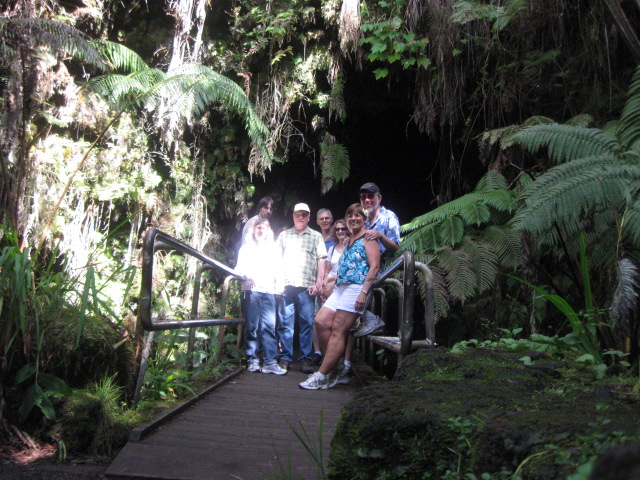
Volcanoes National Park Tour |
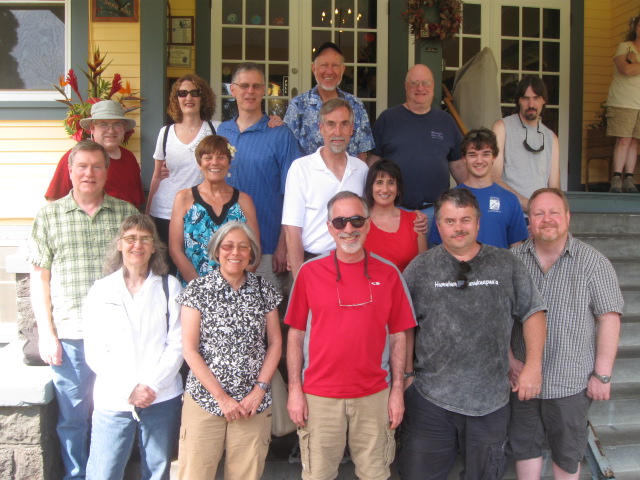
Volcanoes National Park Tour - Lunch! |
|
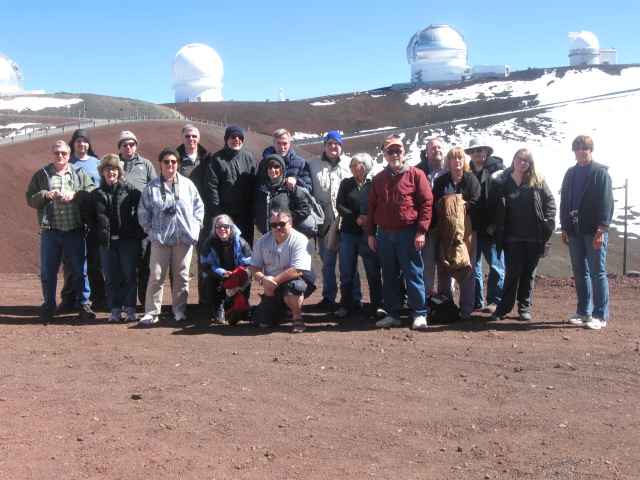
Gemini / Canada-France-Hawaii Telescope Tours |
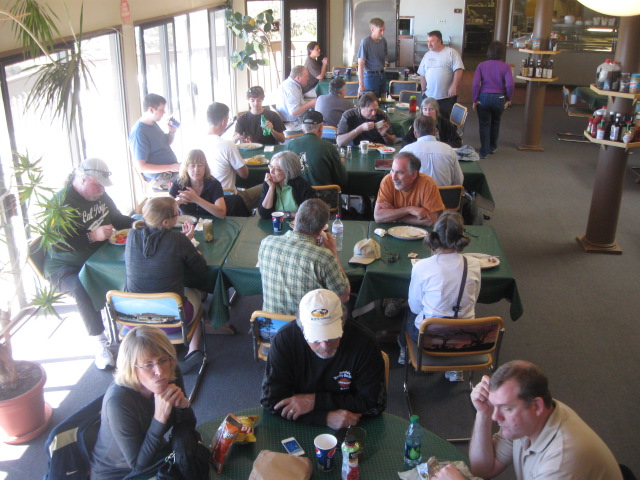
Lunch at the 9000 ft Astronomers Center to aclimatize |
2010-2011 Conferences
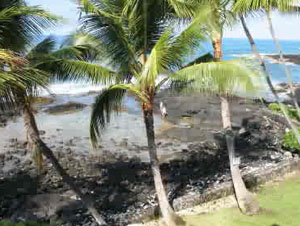 |
Telescopes
from Afar
Robotic Observatories
February 28-March 3, 2011
Waikaloa Marriott
North of Kona, Big Island of Hawaii
Sponsored by the
Canada France Hawaii Telescope
& the Alt-Az Initiative
Just Completed
(Click here for Website) |
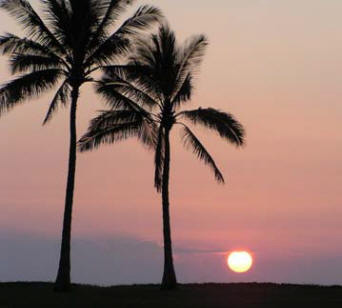 |
LIGHT
BUCKET ASTRONOMY CONFERENCE
Technology Developments
and Research Programs
Canada-France-Hawaii Telescope Headquarters, Waimea, Big Island of Hawaii
31 December 2010 - 2 January 2011
Co-Chairs
Russ Genet (Calif. Polytechnic State Univ.), and Bruce Holenstein (Gravic, Inc.)
Local Hosts
Josh Walawender (Univ. of Hawaii Institute for Astronomy), and Sarah Gajardhar (CFHT)
Conference Webmaster
Cheryl Genet
Mauna Loa /
Mauna
Kea pre-conference tours
29/30 December
Volcanoes National Park post-conference tour - 3 January
Click here for
conference website
Click
here for a printable pdf information version |
|
Conference Goals
The goals
of the conference are two fold. First, to explore how new
technologies can be applied to developing lightweight, low cost,
meter class “light bucket” telescopes and their instrumentation.
Second, to describe the scientific research programs that would most
benefit from telescopes which are so low in initial and operational
cost that entire telescopes or even arrays of telescopes can be
dedicated to specific research programs.
What is light bucket
astronomy?
Jacquelyn
Mitton, in the Cambridge Dictionary of Astronomy (2001),
defines a light bucket as “A colloquial
expression for a flux collector.” She defines a flux
collector, in turn, as “A telescope designed solely to
collect radiation in order to measure its intensity or to carry out
spectral analysis,” mentioning that, “No attempt is made to form an
image so a flux collector can have a more crudely figured reflective
surface than a conventional telescope.” We have extended Mitton’s
light bucket definition to include photometric CCD “imaging” with
low quality, low cost optics (typically one wave or less as opposed
to quarter wave or better optics).
Light
bucket telescopes excel in comparison with smaller aperture, more
expensive, diffraction-limited telescopes when the sky background is
a small or nearly negligible source of noise. This situation can
occur when: (1) the object being observed is very bright, (2) the
integration times are very short and hence photon arrival noise
becomes important, (3) scintillation noise becomes a dominant noise
source, (4) the bandwidth is very narrow or the light is spread out
as in spectroscopy resulting in significant photon arrival noise, or
(5) noise from the detector is dominant, as it can be in the near
infrared.
Science
programs well suited for light bucket astronomy include: many high
speed phenomena, including lunar and asteroid occultations; fast
cadence, high precision CCD photometry; near infrared
diaphragm-limiting or area photometry; low to medium resolution
spectroscopy; and polarimetry. Finally, we note that an array of a
half-dozen light bucket telescopes equipped with very high speed
photometers could, with their many two-telescope combinations,
provide images of the surfaces of nearby stars via intensity
interferometry—a quantum-mechanical effect that occurs at
sub-nanosecond timescales. Such an array would be a modern
extension of Hanbury Brown’s pioneering research, decades ago, with
his two-telescope interferometer in Narrabri, Australia.
Special thanks to Bruce Holenstein's friends
Jonathan and Nancy Sechrist at
Makahiki Farms
for
sponsoring the special
“Dark Night Observing” roast
Kona coffee
for the conference
http://www.makahikifarms.com
|
|
Conference Talks
»» Talk slide pdfs
and audio-visuals ««
are linked beside the speakers below
Special
Talk
Kepler: Are There Any Good Worlds Out There? Jon Jenkens
Talk slides Music
Light Bucket Astronomy
Light Bucket Astronomy, Russ Genet and Bruce Holenstein
Talk slides
Visions for Large Light Buckets, Russ Genet and Bruce
Holenstein
Talk slides
Aberration Theory and Prototype Mirror Experiments,
Bruce Holenstein
Talk slides
Signal-to-Noise of Program Object Measures, Bruce
Holenstein
Talk slides
Innovation
Innovation and the American Amateur Spirit, Jack Hitt
Talks slides
The Other Side of Innovation, Chris Trimble
Talk slides
Meter Class Portable Telescopes
Portable Computerized 1 Meter Telescope, Russ Genet, and
Reed and Chris Estrada
Talk slides
Meniscus Mirror Portable Telescope, Olivier Guyon
Portable 1 Meter Telescope, Mike Connelley
Kilns and Slumping
Low Cost Kilns, David Davis and Andrew Aurigema
Talk slides
A Kiln for Slumping Mirrors, Olivier Guyon.
Foam Glass Composite Mirrors
Foam Glass Composite Mirrors, Andrew Aurigema
Talk
slides
Video links
Lightweight Mirror Experiments, David Davis
Talk slides Video
links
Tessellated Foam Glass Mirrors, David Davis
Talk slides
Mirror Coating Technologies
Deposition Silvering, Sagar Venkateswaran
Talk slides
Silvering and Overcoating Experiments, Bruce Holenstein,
Sagar Venkateswaran,
Mike Holenstein, and Dylan Holenstein
Talk slides
Introduction to Sol-Gel Processes, Lisa Brodhacker
Talk slides
Passive and Active Primary Mirror Support Systems
Low Cost Air Bag Mirror Support System, Steve Taylor
Talk slides
Active Primary Mirror Support Experiment, Mike Connelley
Talk slides
Low Cost Fixed and Bimorph Correctors, Bruce Holenstein
Talk slides
Telescope and Observatory Control Systems
Sidereal Technology Control System Developments, Dan
Gray
Talk slides
Movie
Dedicated Systems: Small Telescopes in the Era of Big
Science, Josh Walawender
Talk slides
The Case for Automated Telescopes, Josh Walawender
Talk slides
Near Infrared Aperture Photometry
Progress Report on a J/H(Ks) Aperture Photometer, Greg
Jones
Talk slides
Telescope Design Considerations for Near Infrared
Photometry, Mike Connelley
Talk slides
High Time Resolution Photometry
Experiments with High Speed Cameras, Bruce Holenstein
Talk slides
A High Speed Electrometer for Photodiode Photometers,
Bruce Holenstein
Talk slides
Methods for Time Stamping Analog and Digital Video,
Frank Suits
Talk
slides
Occultation Timing Accuracy: Dependence on Frame Rate
and S/N, Frank Suits
Talk slides
Occultation Photometry
Missions for Portable Meter Class Telescopes, David
Dunham
Talk slides
Lunar Occultation Theory and Practice, Bruce Holenstein
Talk slides
Observing Trans-Neptunian Objects with Portable
Telescopes, Marc Buie
Talk slides
Portable Occultation Telescope Requirements, EliotYoung
Talk slides
Portable Occultation Systems for Studies of Pluto and
Triton, Leslie Young and Cathy Olkin
Talk slides
Webslides
(These are large file so please be patient) |
Back to Top
2008-2009 Conference
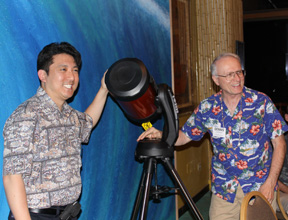
Celestron kindly donated an 8" Telescope as
a
door prize. Celestron's Kevin Kawai makes
presentation to happy winner Dennis Hoofnagle |
Galileo's Legacy
Conference
A celebration of
small telescopes
and astronomical research
four centuries later
Makaha
Resort
Waianae, Oahu, Hawaii
December 31, 2008
- January 5, 2009
Inaugural Speaker -
Susana Deustua
Keynote Speaker - Arne Henden
Luau Speaker - Richard Berry
Photo Gallery Wrap-up |
|
In 1609, Galileo turned
his newly made telescope toward the heavens and, in
rapid succession, discovered the mountains on the Moon,
a multitude of previously invisible stars, and four
moons orbiting Jupiter. Many of Galileo’s observations
were made from his backyard. Four centuries after
Galileo’s 1609 observations—thanks to the revolutionary
trio of affordable CCD cameras, small go-to telescopes,
and personal computers—thousands of backyard Galileo's
around the planet are now probing cosmic mysteries every
clear night. They conduct scientific research across a
broad spectrum: tumbling asteroids, pulsating stars,
eclipsing binaries, transiting planets, and sputtering
matter as it spirals onto white dwarfs and neutron
stars.
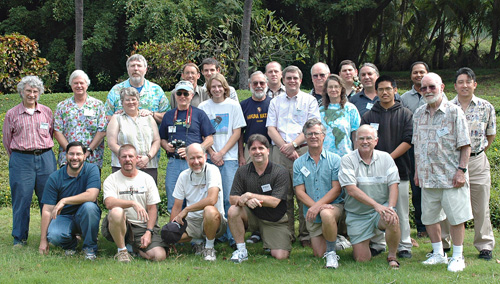
To commemorate Galileo and celebrate his legacy, 2009
has been designated the International Year of Astronomy
(IYA). This conference honored Galileo and his
telescope, by way of the many current builders and
researchers—amateurs, students, and professionals—who
are successfully designing, building, and using small
telescopes, CCD cameras, and even spectrographs to
advance astronomical science. The conference
celebrated Galileo’s achievements by examining his
legacy: the remarkable resurgence of small telescopes
and their science.
|
Galileo's Legacy Conference Agenda of
Talks and Workshops
Thursday,
January 1st Telescope Control and Mirror Developments
8:40-9:00 Russ Genet Intermediate Aperture Alt-Az
Telescope Development Program
9:00-9:20 Dan Gray Direct Drive Axial Flux Motors
9:20-9:40 Dan Gray Brushless DC Telescope
Controller
9:40-10:00 Kiran Shah Epoxy Spin-Cast Mirrors
10:30-10:45
Andrew Aurigema Acrylic Plastic Mirrors for Hyper-Fast 3-D
Telescopes
10:45-11:00
Andrew Aurigema Vacuum Deposition Coating of Non-Traditional Mirror
Materials
11:00-11:20 Andrew Aurigema Foam Glass Sandwich Mirrors
11:20-11:40
David Davis Hogging with Heat: Kiln Forming Saggital Depth
Curves
in Thin Plate Glass
11:40-12:00
David Davis Composite
Mirrors, Pushing the Envelope
4:00-5:30 Workshop Alt-Az Telescope Development
8:00-9:00 Arne Henden Keynote Talk: Variable Star Observing
for Fun and Profit
Friday,
January 2nd Solar Research, Remote Observatories, and Chandra
8:40-9:00 Sara Martin Solar Prominence Research
Using Small Telescopes
9:00-9:20 Alexander Wen An Investigation of Exceptions to the Hemispheric Pattern of Chirality
of
Solar Prominences and Related Features
9:20-9:40 Tom Smith Dark Ridge Observatory Overview
9:40-10:00 Tom Smith Remote Observing for Students
10:30-10:50
Robert Rea Regent Lane Observatory
10:50-11:10 Kevin Ivarsen Skynet and PROMPT: Overview of a Global
Telescope Network
11:10-11:40
Donna Young The Chandra X-ray
Satellite and AAVSO Education Outreach Initiative
11:40-12:00
Terry Matilsky DS9 Image Analysis Software
12:00-12:20
Doug Lombardi Decoding Starlight and Imaging
3:30-5:30 Workshop Chandra
8:00-9:00 Tom Johnson Historical Talk: The Schmidt
Corrector and the Founding of Celestron
Saturday,
January 3rd Day off, Luau, and Remote Double Star Observing
8:05-9:00 Richard Berry
Luau Talk: Galileo Meets Babbage: The Evolution of Data in
Astronomical
Science (Pokai Room)
Sunday,
January 4th Research as Education, Instruments, and Science
8:30-8:50 Russ Genet Astronomical Research as
Undergraduate & High School Education
8:50-9:10 Jo Johnson Fall 2008 Astronomy Research
Seminar at Cuesta College
9:10-9:30 Arne Henden Recent Variable Stars of Interest
9:30-9:50 Matt Beaky Pulsating
Stars in Eclipsing Binary Systems
9:50-10:10 Alan Holmes
Capabilities and Limitations of
Amateur Spectroscopy
10:40-11:00
Danyal Medley Small Telescope Developments at Celestron
1:00-11:20
Kent Clark Introduction to Visual Double Stars
11:20-11:40
Kent Clark Measurement of the Proper Motion of ENG 7B - A Student Project
11:40-12:00
Bob Nelson Spectroscopy for Eclipsing Binary Light Curve
Analysis
12:00-12:30
Doug Simons Gemini and Tech Transfer
4:00-5:30 Workshop Advanced Technologies
& Tech
Transfer from Larger Smaller Telescopes
8:00-9:00 Alan Holmes Keynote Talk: Two Decades of
SBIG CCD Cameras
Monday,
January 5th Science and Special Talks
8:40-9:00 Arne Henden Near IR Photometry
9:00-9:20 Dan Gray Automation of the
SSP4
9:20-9:40 Tom Johnson Optical Testing
9:40-10:00 Terrance Redding How
Amateur Astronomers Learn: Engaging High Self-Directed
Learners in Astronomy
10:30-11:00
Scott Degenhardt Introduction to Occultations
11:00-11:20
Scott Degenhardt Multi-Station Occultation Observing with Galileo
Sized Optical Systems
11:20-11:40
Bob Buchheim PSF-Matching for
Measuring Close Double Stars
11:40-12:00
Richard Berry The new Magnitude Measurement Tool in AIP4Win
4:00-5:30 Workshop Science Research and Education
8:05-9:00 Bob Buchheim Aloha Talk:
The Evidence of Things Not Seen (Pokai Room) |
Click here for more
information
|
Back to Top
2008 Conference
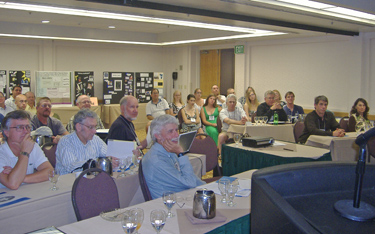 |
STAR
SMALL
TELESCOPES
&
ASTRONOMICAL
RESEARCH
Conference on smaller telescopes (2 meters or less)
Their development & use in research & education
June 19-22, 2008
San
Luis Obispo, California
Original Website |
|
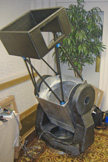
Cal Poly 18 |
Affordable CCD cameras, compact go-to telescopes, and
powerful personal computers (not to mention DSLR and video cameras) have transformed small
telescopes into powerful tools for astronomical research. “Dobsonian”
mirrors up to one-meter aperture and affordable control systems are
being combined into highly capable equatorial and alt-az telescopes.
These larger telescopes not only allow precise astrometric and
photometric observations of faint objects but, with recently available
spectrographs, both time-series and classification spectroscopy are now
affordable. Robotic and remote access small telescopes are facilitating
observations both locally and remotely around the globe. High school and
undergraduate students are joining the ranks of amateur and professional
astronomers in utilizing small telescopes for astronomical research.
Whether conducting astronomical research or developing new telescopes or
software, students gain invaluable hands-on experience in science and
engineering while, as coauthors of published papers, their careers are
given a boost. |
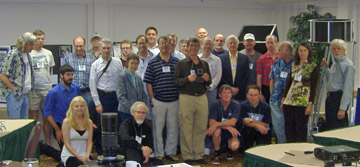
|
STAR Conference Agenda of Talks and Workshops
Thursday, June 19
Evening Presentations (7:30-9:00)
Arne Henden – You Should Observe Variable Stars!
Friday, June 20
Opening (8:00-8:20)
Bob Buchheim – Evidence of Things Not Seen
Telescopes
I (8:20-10:00)
Rick Hedrick – PlaneWave Telescopes
Dan Grey – The New Sidereal Technology Telescope
Control System
Russ Genet – Modest Aperture Alt-Az Research
Telescopes
George Alers –
Bringing an Old LX10 into the Digital Age
Telescopes
II (10:30-11:50)
Curtis mead – All Sky Optical SETI: The Greatest
Hits
Erick Kopit –
Orion Products for
Astronomical Research at Affordable Prices
Tom Osypowski – A Commercial Aluminum Telescope
Matt Swanson, Michelle Kirkup, and Josh Schmitt
– Design and Fabrication of an Optical Tube
Assembly
for an 18 Inch Alt-Az Telescope
Instrumentation (11:50-12:30)
Richard Crisp I – Trends in CCD Sensor
Development
Richard Crisp II – Polarization Imaging Using
Stokes Parameters
Kit
Telescope Workshop (2:00-2:30)
Erick Kopit, Dan Grey, Russ Genet, Rick Hedrick,
Michelle Kirkup, John Ridgely
1.5
Meter Telescope Challenge Workshop (2:30-3:00)
Russ Genet, Curtis Mead, Arne Hendon, Dan Grey,
Matt Swanson, John Ridgely
Telescope Technology Workshop (3:30-4:00)
Dan Grey, Tom Osypowski, Tom Smith, Erick Kopit,
Rick Hedrick, Josh Schmitt
Instrumentation Workshop (4:00-4:30)
Curtis Mead, Bob Buchheim, Arne Hendon, Dan
Grey, Richard Crisp, Rich Williams
Guest Talk
(Evening)
Wayne
Rosing – Las Cumbres Observatory Global
Telescope Network
Double Star
Astrometry
Tom
Frey – What are Double Stars?
Kent Clark – The
Journal of Double
Star Observations
Stephanie Marble, Christianne Gonzales, Corey
Cameron, and Sarah Fishbein –
High School Student Observations of the Visual
Double Star 3 Pegasi
Exoplanet Transits
Jim
Carlisle, Tom Smith, and Jolyon Johnson –
Transiting Exoplanet WASP-1b
Telescope
Engineering
John Ridgely – Cal Poly Mechanical Engineering
Senior Projects Class
Matt Swanson, Michelle Kirkup, and Josh Schmitt
– 18 Inch Telescope Optical Tube Assembly
Raymond Desmarais – Large Lightweight
Inexpensive Telescopes
Brittany McCrigler and George Alers – Upgrading
an LX10
Local
Astronomy Programs
Dave Mitchell – Cal Poly Astronomy Program
Russ Genet – Cuesta College Astronomy Program
Vera Wallen – Cuesta College Physics Research
Seminar
Walt Reil – Central Coast Astronomical Society
Saturday, June 21
Opening (8:00-8:20)
Wayne Rosing – Las Cumbres Observatory Global
Telescope Network
Double Star
Astrometry (8:20-9:20)
Kent Clark –
All About the
Journal
of Double Star Observations
Dave Arnold – Considering Proper Motion in the
Analysis of Visual Double Stars
Tom Frey – Visual Double Star Measurements with
an Alt-Az Telescope
Exoplanet
Microlensing and Transits (9:20-10:00)
Andrew Gould – MicroFUN: Amateur + Professional
Collaboration to Find Planets Using
Gravitational Microlensing
Jolyon Johnson – Observations of Exoplanet
WASP-1b Suggest Early Transit
Solar
Phenomena and Time Series Photometry
(10:30-12:30)
Sara Martin – An Abundance of Research
Opportunities Using Small Solar Telescopes
Mark Wagner – Filters for Solar Research”
Brittany McCrigler I – Discovery of a New
Variable Star
Brittany McCrigler II – Period Analysis of the
Asteroid 2 Pallas
Sunday,
June 22
Opening (8:00-8:20)
Arne Hendon – An Introduction to Infrared
Photometry
Remote and
Robotic Observatories (8:20-10:00)
Tom Smith – Collaboration and Remote Student
Research at the Dark Ridge Observatory
Rich Williams – Commercial Remote Observatories:
Flexible, Expedient, and Cost Effective
Facilities for
Astronomy Research and Education Projects
Gary Cole – Small Telescope Automated
Spectroscopy
Russ Rob – Astronomical Research at Victoria
University
Research as
Education (10:30-12:30)
Russ Genet – Astronomical Research as Science
Education
Vera Wallen – Student Astronomical Research: An
Educator’s Perspective
Jolyon Johnson – Double Star Observations by the
Cuesta College Research Seminar
Jim Carlisle – The Road to Exoplanet Study
Double Star
Astrometry Workshop (2:00-2:30)
Kent Clark, Dave Arnold, Tom Frey, Jolyon
Johnson, Bob Buchheim, Russ Genet
Exoplanet
Transits and Microlensing Workshop (2:30-3:00)
Andrew Gould, Jim Carlisle, Arne Hendon, Tom
Smith, Jolyon Johnson, Bob Buchheim
Remote/Robotic Observatories Workshop
(3:30-4:00)
Tom Smith, Rich Williams, Russ Genet, Arne
Hendon, Curtis Mead, Gary Cole
Research as Education Workshop (4:00-4:30)
Vera Wallen, Arne Hendon, Russ Genet, Jolyon
Johnson, Tom Smith, Bob Buchheim
Evening
Presentations (7:30-9:00)
Richard
Berry – Astronomy in Africa and Visiting the
South Africa Large Telescope (SALT) |
Click here for more
information |
Back to Top
WORKSHOPS
2010 Workshop
|
Portland IV
Alt-Az
Initiative Workshop
at
Sidereal Technology
Held
July 31 – August 1, 2010 Portland, Oregon |
|
The Portland IV
Annual Alt-Az Initiative Workshop was held on Saturday and
Sunday at Dan Gray's Sidereal Technology plant, preceded by an
informal BBQ on Friday evening, July 30. Last year’s Portland
III Workshop featured a wide variety of speakers, and was
featured in Amateur Astronomy magazine as will be this
year’s workshop. Topics this year included lightweight
mirrors, large alt-az telescopes, advanced control systems,
instruments (including near IR aperture photometers), and other
topics. Howard Banich chaired the workshop (howard.banich@nike.com), and Dan Gray
was
the local host.
Agenda
Friday, 7/30 (6pm)
Welcome BBQ at TMS
Saturday 7/31 (8:30am)
Introduction and agenda review –
Howard
“What’s the telescope for?” –
Richard,
Russ
Research opportunities –
Richard, Jo, David, Russ,
Gary Cole. Bob Nelson, David Haworth, Bruce:
Occultations (Lunar and asteroid)
Light Bucket astronomy –
Bruce:
Light Bucket Mirrors,
some
light bucket mirror theory (figures of merit
overview),
Pneumatic LBTs, Evaluation of other new types and coatings
(Starstone, solar, Peacock Labs).
Russ
Visual observing -
Howard
Brief history of the alt-az telescope –
Richard, Peter Abrahams
Herschel and Lord Rosse –
Richard
Mirror technologies –
Mel, David, Drew, Peter Chen, Bruce, Umesh and Brian
Active primary and secondary optics
–
Umesh:
Closed loop control of membrane mirrors using electrostatic
actuators, Brian:
Laboratory experiments on electrostatically controlled membrane
mirrors, Bruce:
Correctors –Lenses, Deformable Secondary.
Greg
Spherical aberration correction via spherical refractive
elements -
Dave
Sunday, 8/1 (9:00am)
Direct drive motor and controller –
Dan, Dave and the PlaneWave gang
Instrumentation –
Greg, Dan,
Bruce:
Fast Detectors, Area (CCD & CMOS) and diaphragm (high speed
electrometer design)
Update on Russ Genet’s 1 meter scope –
Russ
Professional alt-az updates –
PlaneWave, Craig
CDK700 - Dave
1 meter CDK Cassegrain –
Dave
Future plans - what scopes and instruments are being planned by
participants?
Large
Telescope Portability -
Howard
SPIE update –
Russ
Wrap up, going forward –
Howard, Russ
|
2009 Workshops
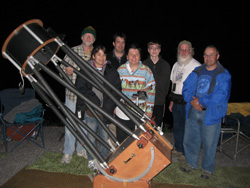
Tom Frey's team used his 18” Obsession to
observe double stars |
Pine Mountain
Observatory Summer Research
Workshop 2009
July 17-19, 2009
Pine Mountain Oregon
Local Host: Mark Dunaway
|
|
Three schools,
St. Mary's School in Medford, South Eugene High School
in Eugene, and Willamette University in Salem
participated in the Pine Mountain Observatory Summer
Research Workshop 2009. The workshop was only three days
long. To accomplish the goals of the workshop, Richard
Berry, Jo Johnson, and Thomas Frey were invited as
instructors to the students and high school teachers.
Richard Berry led a variable star photometry project as
well as a proper motion astrometry project. Jo and Tom
led visual double star astrometry projects. Each of the
instructors also gave lectures on the first day to
introduce the students to the topics of their research.
None of the students had made quantitative astronomical
measurements before. Each team wrote up a paper
describing the research they had done. Three papers in
all were submitted for publication.
Dan Gray continued his project for automated IR
photometry of variable stars and Russ Genet made considerable
progress on the design of a 1 meter alt-az telescope for
the Orion Observatory, which he directs. Finally, the
editors of the Small Telescopes and Astronomical
Research book, Russ Genet, Jo Johnson, and Vera
Wallen met at the workshop to finish preliminary editing
of all chapters and Cheryl Genet, managing editor of the
Collins Foundation Press, typeset the chapters in
InDesign. |
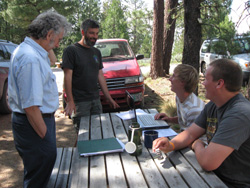
Richard Berry's
team made photometric and astrometric measurements |
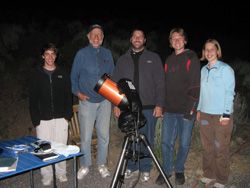
Jo Johnson's team observed double stars
on Russ Genet's NexStar 6 |
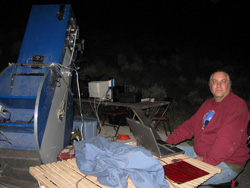
Dan Gray makes automated IR measurements |
|
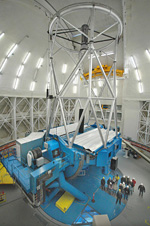
Gemini workshop tour group (bottom right) and the Gemini
telescope |
Gemini Observatory Tour Workshop
January 7, 2009
Hilo, Hawaii
|
After the January conference, Galileo's
Legacy: Small Telescopes and Astronomical
Research, over a dozen astronomers and
engineers visited the Gemini telescope on Mauna
Kea for an "insiders tour." They stopped
at the Hale Pohaku Astronomer's Hotel (9000 ft
level) to have lunch and acclimatize to the
altitude before ascending to the top of mountain
at 14,000 feet. During this workshop they
continued their discussions of alt-az telescope
technologies and saw the Gemini implementation
of some of these technologies first hand. |
|
Back to Top
2008 Workshop
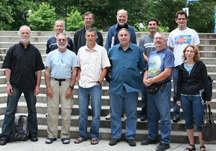 |
Vancouver 1-2 Meter Telescope Workshop
July 25-26, 2008
University of British Columbia
Vancouver, BC, Canada
Organizers: Craig Breckenridge &
Russ Genet
|
Craig Breckenridge,
members of the Vancouver ATM community, local
professionals from the large aperture telescope
design field, and the low cost 1.5 meter alt-az
telescope development team met to discuss all
aspects of 1M to 2M class instruments and their
enclosures and to reviewing preliminary design
alternatives for the low cost 1.5 meter telescope.
The
Schedule for the Vancouver Telescope Workshop was
as follows:
Friday,
July 25th – Arrival Dinner / Possible
Observing
2:00 – 6:00 Arrivals self
check in at Gage Towers, informal discussions at
Gage
6:00 – 9:00 Social hour,
informal Dutch treat dinner (guest speaker and slide
show after dinner)
9:00 - ??? Possible
Observing at either UBC's .42M telescope or the
Gordon McMillan Southam Observatory's .5M telescope
(Craig Breckenridge design)
Saturday, July 26th – 1-2 Meter Telescope
Workshop
Overview and discussion of
current technologies and future potentials for
telescopes in the 1-2 meter range. Emphasis on the
potential for applying some of the lessons learned
in larger alt-az telescopes to modest aperture
alt-az systems in a manner that could result in
unusually lightweight, low cost telescopes.
8:00 - 9:00 Plenary
Session
9:00 - 10:00 Optics
Workshop
10:15 - 11:15 Structural
Workshop
11:15 - 12:15 Mechanical
Workshop
1:15 - 2:15 Controls
Workshop
2:15 - 3:15 Operational
Workshop (autoguiding and active primaries)
3:30 - 4:30 Observatory
Workshop
9:00 PM
Observing with the Royal Astronomical Society of
Canada, Vancouver Centre at their inaugural local
Star Party (in Fort Langley - about 1 1/2 hour
drive).
Sunday,
July 27th – 1.5 Meter Telescope
Preliminary Design Review
The 1.5 meter project is
developing a lightweight, low cost telescope for
dedicated near-IR photometry and fiber fed optical
spectroscopy. Several preliminary design
alternatives were presented for critique by the
attendees with the hope of selecting one option for
further detailed design and construction.
8:00 - 9:00 Overview
briefings on the 1.5 meter telescope project and
applications
9:00 - 10:00 Panel
discussion on the 1.5 meter project, NIR, and
spectroscopy
10:15 - 11:15 Briefings on
1.5 meter design alternatives
11:15 - 12:15 Panel
critique and recommendation for design alternative
Atendees
Dan Gray, Russ Genet, Craig Breckenridge, Howard
Trottier, Merle Halpern, Nathan Loewen, Eric Fuller,
Juan C. Diaz, Marcel, Kreig McBride, Greg Burley,
Bob Nelson, Mikhail Rosenberg
|
Back to Top
|
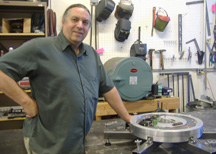
Dan Gray with a direct drive motor |
Portland Workshop II
July 24, 2008
Sidereal Technology
Portland, Oregon
Local Host: Dan Gray
|
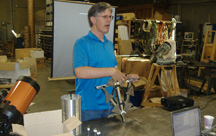
Howard Banich Presents to Participants |
Sidereal Technology hosted, for the second time,
a Portland workshop devoted to the design,
construction, and use of high tech, modest
aperture, low cost, alt-az telescopes. The
telescopes and designs we discussed were all
high tech in the sense that they were
computer-controlled precision goto/tracking
telescopes that used aerospace materials as
appropriate. We limited ourselves to 2 meters
or less in aperture, except for several larger
alt-az telescopes we have visited for
inspiration such as the 2.4-meter Magdalena
Ridge Observatory and 8-meter Gemini and Subaru
telescopes.
One can purchase wonderfully designed and
manufactured alt-az telescopes in the 1 to 2
meter range from firms such as ESO Technologies,
DFM Engineering, and others. These systems
are excellent values. Our group’s interest
centers on addressing how telescopes of much
lower cost—an order of magnitude lower—might be
designed and produced. Of course there are
no free lunches, so such low costs would have to
depend on technological breakthroughs, limited
telescope capabilities (such as specialized,
dedicated mission telescopes), be standardized
and manufactured in quantity, or have
somewhat lower optical quality, etc.
Attendees
Peter Abrahams, Tim Anderson, Howard Banich, Mel
Bartels, Richard Berry, Mike Colyar, Nathan
Corrier,
Russ Genet, Dan Gray, David Haworth, Greg Jones,
Don Peckham, Greg Rohde, and Malcom Saunders
Agenda
Dan Gray:
High Resolution Encoder, Hand Controller, Direct
Dive Motor Controller, Optec SSP-4 Automation,
Cal Poly 18 Inch Telescope, Instrument Rotator
Projects, Alt-Az 16 Inch Telescope.
Tim Anderson:
Memory Foam Mirror Cell for Thin Mirror.
Dave Rowe:
Direct Drive Motors, High Resolution Encoder,
CDK Design / 2 Meter Telescope, Spherical
Correctors, Corrected Hyperbolic Newtonian,
Optec SSP-4 Results, IR Detectors Possibilities,
Darwin Optical Analysis Program,
Multiple OTA Telescope / Four Shooter.
Howard Banich:
Conversion of 28 Inch Telescope, Primary Mirror
Cell for 18 Inch Telescope, Secondary Mirror,
Structure for 18 Inch Telescope.
Peter Abrahams:
Early Computer Controlled and Robotic
Telescopes.
Russ Genet:
Lightweight Mirrors, Goto Dobs.
Mike Colyar:
High Speed Photometry, Oil Pad Systems, Preload
Springs From Recoil Starters.
Richard Berry:
Science Programs for Advanced Telescopes,
Alternative Instrument Payload Configurations.
Greg Rohde:
Fused Quartz Mirror Cells.
Malcom Sanders:
Problems with 700mm Telescope.
|
Back to Top
2008 Workshop
Back to Top
2008 Workshop
|
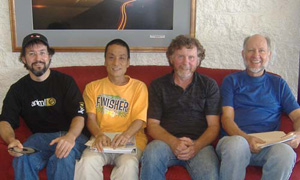
Chris, Daigo, Mike, & Russ |
Gemini/Subaru
Workshop II
February 23-25, 2008
Hilo, Hawaii
A second workshop was held in Hilo, February 2008, with
Chris Carter (Gemini Controls), Daigo Tomono (Subaru
Mechanical), Mike Sheehan (Gemini Mechanical), and Russ
Genet (Alt-Az Initiative). The first part of the
workshop was devoted to roughing out a conceptual design
for a lightweight (under 1000 lb.), low cost 2.0 meter
telescope for dedicated, fairly narrow field-of-view
applications such as time series photometry or fiber-fed
spectroscopy. The conceptual telescope employed four
1-meter spherical mirrors that would be co-aligned and
co-focused, albeit not co-phased. Instruments were
placed on the top of struts at prime focus behind a
refractive spherical aberration corrector. The
second part of the workshop was devoted to discussing
active correction of a primary mirror figure via "voice
coil" tweaking as the telescope changed its azimuth. The
amount of "tweaks" needed to overcome
mirror "slumping" would be determined off line
by observing bright stars at a range of altitudes. These
values would be stored in a lookup table
& interpolated to the telescope's current altitude, an
approached used successfully by the Subaru 8 m
telescope. |
|
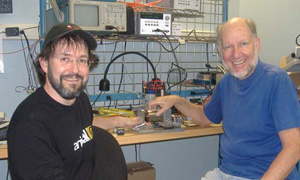
Chris and Russ with voice coil |
Back to Top
2008 Workshop
|
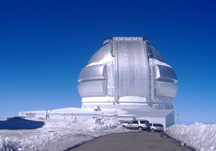
Gemini Observatory - Mauna Kea |
Gemini and Subaru
Observatory Tours
and Workshop I
January, 2008
Hilo, Hawaii |
|
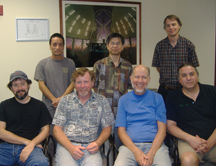
Workshop at Gemini Headquarters |
The large telescopes
have pioneered many of the techniques that can now
be applied at greatly reduced cost thanks to
advancements in electronics and materials. The
large telescope engineers seem to genuinely enjoy
discussing the challenges of applying what they
have learned on a much smaller scale and greatly
reduced budget.
Alt-Az Initiative
members Russ Genet and Dan Gray met with Gemini
engineers Chris Carter and Mike Sheehan and Subaru
engineers Daigo Tomono and Hicleki Takami in Hilo on
the big island of Hawaii. Gemini Director Doug
Simons joined us during our meeting. A visit to the
8-meter Gemini and Subaru telescopes on Mauna Kea
followed the meeting. Chris Carter guided Russ and
Dan Gray through Gemini, while Diago Tomono guided
them through Subaru.
Both the Gemini and
Subaru telescopes use thin meniscus primary
mirrors. The mirror blanks were cast at Corning
from ULE. Passive supports alone would be
inadequate for these mirrors, so their figures are
fine tuned with actuators which actively apply
forces to the backs of the mirrors. The Subaru has
a diameter to thickness ratio of 60:1. What was of
great interest to us was that once the necessary
forces for various elevations and temperatures were
determined, they could be used for months in a table
look-up fashion before they needed to be refined.
This was important for our smaller alt-az telescope
to know, because we have been considering using a
thin meniscus mirror in our 1.0 to 2.0 meter
telescopes with active control and were hoping that
we could make calibration measurements off line and
just interpolate from a table during normal
operation.
Click here for pdf of article published in Astronomy
Today |
|
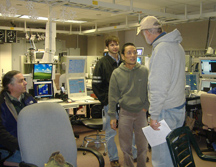
Consultation in Subaru Control Room |
|
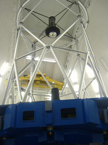
Gemini Telescope |
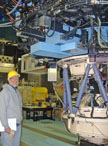
Subaru Instruments |
Back to Top
2007 Workshop
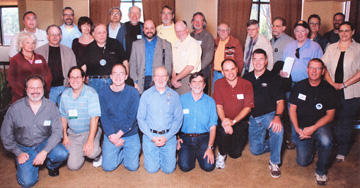 |
Texas Astronomical
Society of
Dallas
High-Tech Alt-Az Telescope Workshop
October 26-27, 2007
Dallas, Texas
Program Organizer: Russ Genet
Local Host: Max Corneau
http://texasastro.org |
Evening Kickoff
at the Texas Astronomical Society of Dallas’s
General Meeting at the University of Texas, Dallas,
Friday evening, October 26, 7:00-8:30 PM. A
40-minute presentation, High-Tech Alt-Az
Telescopes for Research, Astrophotography, and
Education, by Russ Genet (California Polytechnic
State University) will be followed by a
question-answering panel chaired by Max Corneau with
panel members Russ Genet, Richard Kay, Tom Krajci,
Tom Smith, and Dave Rowe.
All-Day Workshop Saturday,
October 27, 2008, 9:00 AM – 5:00 PM. Please see
workshop agenda below.
Introduction to
Alt-Az Telescopes for Research, Astrophotography, and Education
The combination of
low-cost alt-az telescope control systems and affordable aerospace materials
has reached the point where a revolutionary new class of lightweight, highly
capable alt-az telescopes is emerging. Similar to SCTs, this new class of
alt-az telescopes will not only be used visually, but also for CCD-based
scientific research and astrophotography. Similar to Dobs, they will have
larger apertures than SCTs, yet will be lightweight. Unlike the visual Dobs
but similar to giant mountaintop alt-az telescopes, this emerging class of
precisely controlled telescopes will handle a variety of instruments mounted
on field de-rotators with generous back focus. The primary reason for
developing lightweight alt-az telescopes with apertures larger than SCTs is
to conduct research on and image (as well as view) fainter objects with
affordable telescopes.
The cost of alt-az
telescope control systems has plummeted over the years. Initially, control
computers and telescope control electronics cost tens of thousands of
dollars and filled entire equipment racks. Today, Sidereal Technology makes
a microcomputer-based alt-az telescope control system for about $1,000 that
you can place in your briefcase with room to spare. Meanwhile, the cost of
aerospace materials has plummeted as their use has moved beyond aircraft and
spacecraft to outdoor signs and building exteriors. Given these two
dramatic drops in cost, research-grade alt-az telescopes fabricated from
lightweight aerospace materials are now economically viable.
The objective of the
Dallas Alt-Az Workshop is to explore, in workshop talks and panel
discussions, eight areas:
(1)
lightweight affordable optics
(2)
autoguiding
(3)
precision
control systems and drives
(4)
field
de-rotation
(5)
high
natural frequency mechanical structures
(6)
bearings
for alt-az telescopes
(7)
structural
alternatives
(8)
observatories (automation, scheduling, and remote sites)
Workshop Agenda
830-840 Welcome/Introduction to the Texas
Astronomical Society of Dallas
Max Corneau, Texas Astronomical Society, Dallas
(Vice President)
840-850 Workshop Overview Russ Genet, Cal
Poly Univ.
850-900
Morning Session Introduction Tom Krajci,
Astrokolkhoz
Observatory
900-945 Lightweight Affordable Optics Dave
Rowe, Sierra Monolithics
A wide-field photo-visual alt-az telescope supports
two basic optical configurations: the corrected
Newtonian for smaller systems, and the
tertiary-focus Cassegrain for larger systems. The
first part of this talk will address the
requirements and trade-offs for telescopes of this
class, and will discuss various high-performance
optical designs in detail. Emphasis will be placed
on corrected parabolic Newtonian, corrected
hyperbolic Newtonian, and corrected Dall Kirkham
optical systems. The second part of this talk will
cover the current status and future of large,
lightweight mirror blanks and corrective optics.
Lightweight and inexpensive primary mirrors and
matched correctors are needed to fulfill the promise
of the high-tech telescope.
945-1015 Corrected Dall Kirkham Alt-Az
Telescopes Rick Hedrick, Plane Wave
Instruments
The corrected Dall Kirkham design employed in the
20-inch Plane Wave Instruments OTA is being extended
to alt-az telescopes of 40-inch (1-meter)
telescopes. Why is this optical design particularly
well suited to economical 1-meter telescopes for
research, astrophotography, and education?
1015-1030 Autoguiding
Tom Krajci, Astrokolokhoz Observatory
Autoguiding has been the mainstay of long-exposure
astronomical imaging. This talk will cover the
current status and future of telescope positioning
and position correction. Topics will include
traditional autoguiding using cameras and mount
corrections, faster correction methods using movable
mirrors and deviator plates, and long-exposure
unguided imaging using precision encoders and mount
modeling. The impact on the optical and mechanical
design will be discussed.
1100-1200 Precision control systems and drives
Dan Gray, Sidereal Technology
Sidereal Technology manufactures and supports a
control system that can be used for either
equatorial or alt-az telescopes. Over 100 systems
have been incorporated into telescopes, including
several ATM alt-az systems. An active Yahoo user’s
group helps newcomers and provides ideas for and
evaluations of advances. Besides reviewing the
current control system, this talk will describe new
developments which include “tick management,”
closed-loop operation with high-resolution telescope
encoders, and experiments with the control of
high-torque brushless DC motors. This latter
development could produce active control systems
that directly counter wind gusts one millisecond at
a time.
1200-1230 Field de-rotation Dan Gray,
Sidereal Technology
Although new high-speed CCD cameras, such as
MalinCan and StellaCam, can overcome field rotation
by stacking short exposures, accumulated camera read
noise can be a problem for faint-object photometry
or narrow-band astrophotography. Thus instrument
rotators are still useful for research alt-az
telescopes. Several off-the-shelf instrument
rotators (Meade, Optec, RC Optical Systems) are
available. A proposed development by Sidereal
Technology will also be discussed.
200-210 Afternoon session introduction Tom
Smith, Dark Ridge Observatory
200-230 High natural frequency mechanical
structures Russ Genet, Cal Poly Univ.
Control systems that actively counter wind gusts
with high-torque motors and high-resolution encoders
require, to be effective, very stiff telescope
structures with resonant frequencies above 10 Hertz
(most of the wind gust energy is from 1 to 10
Hertz). Sheet steel is very stiff for its weight
(and very economical), but aerospace materials, such
as carbon fiber and other composites, and aluminum
honeycomb and foam core panels are, pound-for-pound,
even stiffer and lighter than sheet steel. Ordinary
woodworking tools and structural adhesives can be
used to build lightweight alt-az telescopes in a
manner very similar to building balsa wood model
airplanes.
230-300 Bearings for alt-az telescopes
Richard Kay, Impact Bearings, Inc.
While there are many ways to accommodate rotation in
altitude and azimuth, precision bearings is an
approach that has been used with success by the
smaller mountaintop alt-az telescopes, such as the
new 2.4-meter telescope at Magdalena Ridge
Observatory built by EOS Technologies. Although
large-diameter slim-line bearings are somewhat
expensive, they are a viable option for lightweight
alt-az telescopes. Recent advances in bearing
technology will be discussed.
300-330 Structural alternatives panel discussion
Panel Moderator: Max Corneau
Panel Members: Richard Kay, Dave Rowe, Russ Genet,
Tom Smith, and Tom Krajci
There are many structural possibilities for
lightweight alt-az telescopes. The panel will
address a number of questions. Newtonian top ends:
can they achieve low wind resistance? Should truss
or closed OTAs (shroud or otherwise) be used? What
is the best approach to fork designs? Is foam
filled monocoque or stacked aluminum skinned panels
a viable approach? How can altitude and azimuth
drives be integrated into the structure? Should
they be non structural? How should telescopes be
coupled to piers or ground pads? Is the ground too
springy for active control telescopes?
Mid-afternoon break
400-430
Observatories: automation, scheduling, and remote
sites
Tom Smith, Dark Ridge Observatory, and Tom Krajci,
Astrokolokhoz Observatory
Now that you've decided to build a high-tech alt-az
Telescope, how do you automate the observatory so
you can sleep through the night? How do you
schedule observations to make the most of dark
time? If you want to operate at a remote site, how
do you choose it?
430-500 Final panel discussion and summary
statements Panel Moderator: Max Corneau
Panel Members: Richard Kay, Dave Rowe, Russ Genet,
Tom Smith, and Tom Krajci
500 Adjourn
|
Back to Top
2007 Workshop
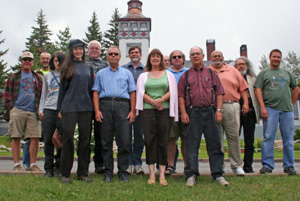 |
RATT II
REMOTE
ACCESS
AUTOMATIC
TELESCOPES
Cloudcroft, New
Mexico
Saturday, August 4, 2007
The Cloudcroft area, besides being
home to several major research obser-vatories, is a hotbed of smaller
observatories, many of which are operated via the Internet from remote
locations.
Left: The RAAT conferees pose in front of the historic Cloudcroft Lodge. |
|
Just over 18 years ago, the first Remote
Access Automatic Telescopes (RAAT) conference was held in Tucson (March
16-19, 1989). Russ Genet (Fairborn Observatory) organized the conference
which was chaired by Dave Crawford (Kitt Peak National Observatory). The
conference was sponsored by the Fairborn Observatory, the Smithsonian
Institution, and the IAPPP. Not long before the conference, an automatic
telescope had received instructions over the Internet, run automatically
all night, and sent the results to the requestor following morning—an
unattended, remote-access procedure that soon became routine.
Russ Genet and David Rowe, the RAAT II
conference organizers, thought it would be worthwhile to revisit this
topic. The Lodge at Cloudcroft was chosen as the venue not only for its
cool summer clime, beauty, and historic charm, but because the
Sacramento Mountains of New Mexico have become a world center for remote
access automatic telescopes of modest aperture. The conference began at 9 AM,
broke for a leisurely lunch, continued during the
afternoon, and then adjourned for a Dutch-treat social hour and dinner.
Talks and discussions were informal.
All subjects dealing with remote access
telescopes, imaging, science and/or educational programs were encouraged,
as were talks on non-automated observatories and all other astronomical
topics of general interest.
|
Back to Top
2007 Workshop
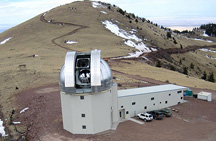 |
Magdalena Ridge
Observatory
Workshop
August 4, 2007
Near Seccoro, New Mexico
Local Host: Elwood Downey, MRO
Chief Engineer
|
A crucial "workshop" was a visit
by Russ Genet, Tom Karjeci, and Tom Smith to
Magdalena Ridge Observatory to see and discuss MRO's
2.4 meter alt-az telescope which, at the time, was
nearing operational status. The 2.4 meter telescope
had been highly recommended to Initiative members as
a particularly good example of a modern, modest
aperture alt-az telescope. MRO's chief engineer,
Elwood Downey, and EOS Technologies Project
Engineer, Kevin Harris, were the hosts. Initiative
members were particularly impressed with the
telescope's direct drives and stiff structure,
inspiring us to look into direct drives more closely
and, eventually, to develop our low cost direct
drives.
|
Back to Top
2007 Workshop
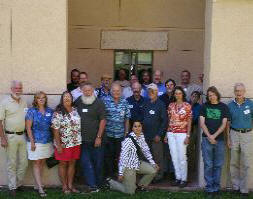 |
STAR
Small Telescope and Astronomical Research
Workshop
June 22-24, 2007
California State Polytechnic University
San Luis Obispo, California
|
|
The STAR
Workshop was sponsored by the Research Scholar in
Residence Program at California Polytechnic State
University (Cal Poly). Late June was chosen as a
time when schools were out but summer vacations had not
started in earnest. The workshop provided a forum
where high school and undergraduate students, amateur
and professional astronomers, educators, and the
commercial designers and manufacturers of small
telescopes, could share their ideas in the rapidly
expanding arenas of small telescope engineering
development, scientific research, and undergraduate
education.
Click here for
and article published in Astronomy Technology Today |
Back to Top
2007 Workshop
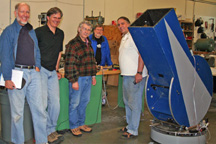
Russ, Howard, Richard, Mel, Dan & 14" |
Portland I
June 10, 2007
Sidereal Technology
Portland, Oregon
Local Host: Dan Gray |
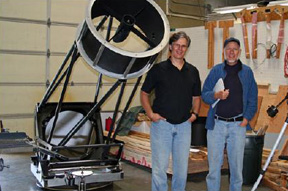
Portable 28", Howard & Russ |
|
The very first meeting of the Alt-Az Initiative took
place June 9-10, 2007, at Dan Gray's Sidereal
Technology/Technical Marine Services plant in Portland,
Oregon. In attendance, as shown in the photo, were Russ
Genet, Howard Banich, Richard Berry, Mel Bartels, and
Dan Gray. This small group began considering the
research missions for alt-az telescopes in the 0.5 to
2.0 meter range, how these missions translated into
engineering requirements and, especially, how new
technical innovations and "tech transfers" from larger
alt-az telescopes might be applied in novel ways to
producing research telescopes that were remarkably
lightweight and low in cost. All the attendees had
designed and built small telescopes themselves. Two
alt-az telescopes were at the workshop--Dan's 14-inch
"Lollipop" and Howard's portable 28 inch which he
brought to the workshop in his VW Microbus and assembled
himself in just minutes. It is not surprising that,
from the very start, the mind set of Alt-Az Initiative's
members was not only on very low cost, lightweight
telescopes, but also on an informally funded, voluntary,
and cooperative do-it-ourselves approach to
development. Dan's shop in Portland was not only host
to another workshop, Portland II, but also to the final
work, assembly, and testing of the Initiative's first
demonstration telescope, the Cal Poly 18.
For Alt-Az
Aerospace Telescope Article (Amateur Astronomy-Winter
2007 - pdf 1.4 MB)
click here |
Back to Top
|